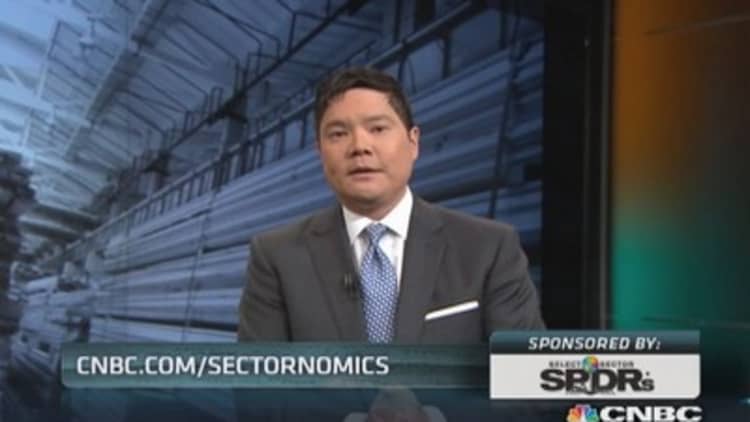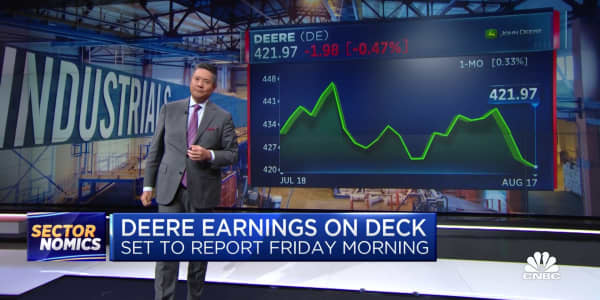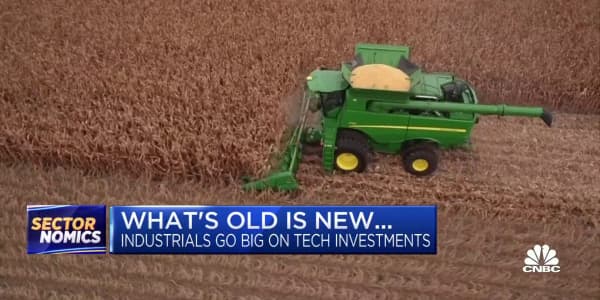In the same way that Internet-enabled devices now allow us to control our home heating and alarm systems via smartphone, sensors placed on gas and oil pipeline wellheads in the Arctic are enabling engineers to monitor mission-critical data from hundreds of miles away, eliminating the need for workers to trek across the tundra to take readings.
Similar scenarios are playing out for corporations that oversee Midwestern wind turbines, offshore oil rigs and Brazilian jetliners: General Electric-made data analytics software lets Gol Airlines analyze and track its flight routes, resulting in millions of dollars in fuel-cost savings and an uptick in productivity.
Welcome to the starting gate of the industrial Internet of Things, the third wave of the digital/Internet revolution that has many economists, equity analysts and technology consultants giddy about what it could do not only for the global economy but also for industrial stocks.
"While this trend hasn't yet proliferated across a wide gamut of industries, these technologies—cloud, mobility, wearables, big data and analytics—will have a profound and transformational impact on industrial processes," said Muthuraman "Ram" Ramasamy, industrial automation and process control industry manager at research firm Frost & Sullivan. "These technologies can be applied with one broad brushstroke across the industrial process, leaving a sustained impact on the industrial value chain."
Pullbacks in capital spending during the recession and the more recent weather-related slowdown have caused a lag in industrials, whose stocks haven't fared as well as banks, retailers and technology firms since the bull market began about five years ago.
The Internet of Things is a bet that this will change, and it is expected to become a significant source of growth and intense competition within the industrial sector. Nontraditional, industrial-centric companies are aggressively and swiftly moving in, and the old guard of oil and gas, transportation and manufacturing companies are bringing their legacy systems online. Twentieth-century machines will link with data-producing sensors and workers to one digital network.
Read MoreThe best sector to own after a market selloff
To date, GE has pulled in about $800 million in revenue from industrial Internet-related sales, up from $290 million last year. GE economists estimate that the wave of innovation unleashed by the industrial Internet could boost global GDP by as much as $10 trillion to $15 trillion over the next 20 years. The conglomerate recently launched Predix, a software development platform engineers can use to create applications for any machine connected to the industrial Internet.
"In the beginning, a lot of the marketplace will be focused on adding sensors to things and connecting them to the Internet," said Hung LeHong, research vice president at research firm Gartner. While GE's lead is definitely impacting the direction of this digital evolution, analysts expect the phenomenon's ripple effect to spread in stages over the next decade or so, with manufacturing, health care and insurance leading its adoption, according to a Gartner estimate. It forecasts incremental revenue generated by the Internet of Things suppliers alone to generate $309 billion by 2020.
From data streams to revenue streams
"If you get a couple of high-profile, winning-use cases that Wall Street buys into, that's a potential to move a stock—that could happen in two years," said Patrick Moorhead, a technology analyst and founder of Moor Insights & Strategy. "If a company like GE can clearly show some very big payback for a customer and that customer gets dragged around the planet as a poster child for the industrial Internet of things, that could give an emotional boost to the Echelons, the Intels and the Freescale Semiconductors."
Moorhead suggested that the companies in line to benefit first may not be the industrials themselves but the crowd of system-on-a-chip and technology-platform providers whose solutions enable devices on different networks to communicate with each other.
Echelon, the San Jose, Calif.-based firm founded 25 years ago by former Apple CEO Mike Markkula, hopes to start shipping its IzoT platform later this year to customers like Honeywell, Siemens and firms in the lighting-control industry who are making the transition from analog to digital lighting. Cisco, which last year merged three of its business teams into its new Internet of Things Business Group, recently announced its IOx computing infrastructure, which will allow customers using its rugged routers far out in the field to more efficiently crunch data.
Read MoreThe trendy tech stocks that aren't getting hammered
Most manufacturers and factories that adopt industrial Internet systems could see a mild stock jump as time and cost savings drive productivity—and their bottom lines—up. But the true driver of a sustained run in industrial stocks will come when corporations find new revenue streams, say some analysts. Profitability will skyrocket when firms effectively learn to find value in the mountains of data flowing in.
"People have realized that the value of analytics on this scale can really change business models," said Kipp Bradford, technology consultant and entrepreneur. "The power of that data extracted from the Internet of Things will allow companies with a traditional business model of selling a tangible asset to sell the service more effectively provided by that asset."
As companies become more adept at analyzing the data flowing in from sensors, "the majority of that revenue will be services—'You're monitoring my air-conditioning; I'm paying you for a service,'" LeHong said.
Bradford and others point to airlines and automakers, whose sensor-laden, Internet-connected planes and cars of the future could allow them to amass—and then sell—information like the maintenance and failure rates of parts and passengers' buying habits. Yet while pinpointing where and how often during the workweek a Prius driver stops for morning coffee may not seem so difficult, recognizing potentially hazardous patterns in the mess of data flowing from an offshore oil rig will take a little longer.
A flood of binary proportions
It'll be incremental growth for the next couple of years. But then we'll see a rocket.Richard Soleydirector, Industrial Internet Consortium
"The flood of massive quantities of data, which contain a lot of noise, is sometimes unreliable and overwhelming," said Tad Patzek, chair of the Department of Petroleum and Geosystems Engineering at the University of Texas at Austin's Cockrell School of Engineering, where students are researching how humans besieged with data react to what they do and don't see. "We're trying to warn the industry that it's becoming more difficult to find nuggets among the weeds," he said.
"It [requires] not only a set of skills but experience and how those skills percolate through you. It will probably take months or years before someone can call themselves truly experienced, which means this becomes a labor-force problem."
A dearth of skilled engineers and laborers—a problem that top engineering schools, including Texas and Georgia Tech, are working on—is only one impediment to widespread adoption of the industrial Internet. Manufacturers are also reluctant to put their systems online until they can be sure the Internet is safe.
"Frankly, one of the advantages of having systems that are siloed and don't talk to one another is that they're not connected to the Internet," said Ron Sege, CEO of Echelon. "And something that's not connected to the outside world is impossible to hack."
Read MoreThe mystery of Google's other revenue
There are also concerns about reliability. "One question that has existed for a while: Is the Internet we use to tweet good enough for a large company to control a valve on an oil pipeline?" said Gartner's LeHong. "When you say to shut that valve off, it has to happen or you get into some safety issues. There is a lot of grayness to that answer, which is: No—we're not ready without doing special magic tricks."

AT&T, Cisco, GE, IBM and Intel plan to tackle these mass adoption issues via the Industrial Internet Consortium, the nonprofit they founded in March to help set engineering standards for connecting large industrial assets. The members, which also include Vanderbilt University and security giant Tyco, are working to define technology test beds—where they will develop the protocols—and have them ready later this year.
"I think that as the companies come together to agree on what interoperability looks like and how systems will work together, it'll be incremental growth for the next couple of years," said Richard Soley, the consortium's executive director. "But then we'll see a rocket."
Lance Roberts, CEO and chief economist at STA Wealth Management in Houston, is a little more conservative with the timeline. "We'll eventually get there, but these are not shovel-ready jobs that will turn on in the next month or so," he said. "For a company like Alcoa—for them to make this leap into creating 'smart aluminum'—it requires a huge capital cost, a massive project that will take years to develop."




